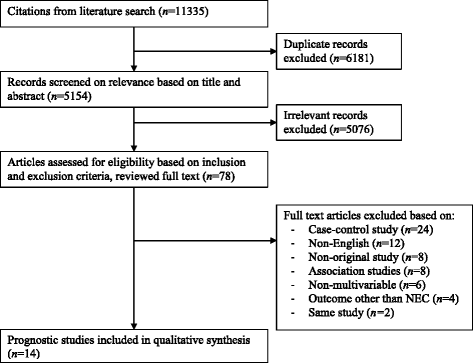Risk factors for necrotizing enterocolitis in neonates: a systematic review of prognostic studies
- PMID: 28410573
- PMCID: PMC5391569
- DOI: 10.1186/s12887-017-0847-3
Risk factors for necrotizing enterocolitis in neonates: a systematic review of prognostic studies
Abstract
Background: Necrotizing enterocolitis (NEC) is a severe multifactorial disease in preterm neonates associated with high morbidity and mortality. Better insight into prognostic values of the many reported factors associated with NEC is needed to enable identification of neonates at risk for NEC. The aim was to systematically review the literature to identify independent risk factors for NEC from the literature.
Methods: Medline, Cochrane, Embase, Pubmed and Google Scholar were searched systematically for cohort studies reporting prognostic factors for NEC in neonates using multivariable analysis. Studies were scored with the Quality In Prognosis Studies tool (QUIPS).
Results: From 5154 initial hits, 14 prognostic studies were included, with various designs. Study quality was rated high in three studies, moderate or low in the 11 others. Significant prognostic factors for NEC reported in at least two studies were: low birth weight, small for gestational age, low gestational age, assisted ventilation, premature rupture of membranes, black ethnicity, sepsis, outborn, hypotension (all increased risk), surfactant therapy (conflicting results) and cesarean section (lower risk). Meta-analysis was considered not feasible.
Conclusion: High quality studies on prognostic factors for NEC are rare. Several prognostic factors, that are not necessarily causal, are associated with NEC. High quality prognostic research is necessary to establish the predictive values of these factors.
Keywords: epidemiology; intestinal perforation; necrotizing enterocolitis; neonatal intensive care unit; preterm; prognosis; risk factors.
Figures
References
Publication types
MeSH terms
LinkOut - more resources
Full Text Sources
Other Literature Sources
Medical


